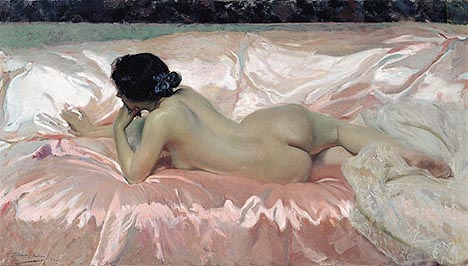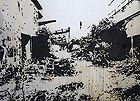
translated and summarized by: Liz Wollner-Grandville,
English summary July 13 - 19
Museo Nacional del Prado: Joaquín Sorolla (1863 – 1923)
Spanish impressions
Joaquín Sorolla (1863 – 1923) is well known for his lucid beach scenes - not only in Spain. Archer Milton Huntington commissioned the highly acclaimed artist to capture the essence of Spanish provinces in a huge mural painting for the Hispanic Society in New York. Between 1913 und 1919, before becoming partially paralyzed and never again able to paint, Sorolla created 14 huge canvases. His “Visiones de Espana” were shipped across the Atlantic and, following their extensive restoration, returned to Spain again in November 2007, where were displayed at the cultural centre Bancaja in Valencia and in circulating exhibition in numerous other Spanish cities.
The Prado in Madrid now opened a large anthology of the artist, presenting 102 paintings of his entire oeuvre of 4.000 works including landscapes, portraits, and beach scenes. Dynamic compositions, lively colours and multi-faceted light reflections immerse even social topics and pure realism into harmonious narrations. He stayed loyal to naturalism in a typically Spanish way, despite all Impressionism. With the view of a photographer and his fast and secure realization, the Mediterranean artist equally masters gravitating portraits, landscape and flower paintings, and quiet everyday life scenes.
The 14 “Visiones de Espana” are among the many works displayed, which are all either in the hands of international museums or private collections. The “Castilla. La fiesta del pan” spans over a width of 14 meters, while the other works of this series are somewhat smaller and measure 3,5 meters in height and between 2,30 and 7,60 m in width. “Castilla” depicts a collage of different villages in Castile and the traditional costumes of its inhabitants, which Sorolla joined in a “feast of bread”. It is comprised of seven canvases and mirrors the austerity of the Castilians, both by the choice of colours as well as by its structure, similar to the Basque melancholy conveyed in “Giupúzcoa: los bolos”.
Dance and colourful motion dominate the Seville-scenes. The catching of tuna (Ayamonte), the cattle drive (Andalusia), and the pilgrimage (Galicia) seem to be able to convey the noise and the smell of the respective scenes. Despite the availability of many studies and photographs, Sorolla painted all of the canvases in situ. An achievement he successfully tackled with the help of unstable wooden frameworks and ladders.
It was Huntington’s goal to deepen the knowledge about Spanish culture in the USA at the beginning of the 20th century. A lively mediation became possible with Sorolla’s works, who had complete artistic freedom for the choice of his motifs. And even if today some viewers might prefer his intimist paintings to the folkloric scenes: the canvases are definitely powerful and beautiful.
By Clementine Kügler
Museo Nacional del Prado
28014 Madrid, Paseo Prado, until 06.09.09
www.museodelprado.es
Lentos Kunstmuseum Linz: Ahoi Herbert! Bayer and Modernism
Linz, Dessau
Back then, they laughed. “Ahoi! Christmas 1933”, Herbert Bayer wrote onto a photo depicting him, Xanti Schawinsky and Walter Gropius in a wanton mood. But not everything was merry. His affair with Ise Gropius triggered a crisis, the Bauhaus was closed, problems with the new ruling power were repressed, but it was clear what was coming, and Schawinsky, head of the Bauhaus-jazz band, fled to Switzerland because of his Jewish origin.
The Photo and its comment are now the poster theme and the title of a large Bayer retrospective presented at the Lentos. Bayer became the shooting star of advertising art, but already left the Bauhaus in 1928 to work as a graphic designer in Berlin. While on the one hand, Bayer’s typographic works from his Weimar and Dessau days and his surrealistic photomontage of the thirties are the stars of Modernism, his concrete paintings, sculptures, landscaping and architectural projects have rarely been shown in Austria; except his “Organ Fountain” in front of the Bruckner House in Linz, which he created after he had already lived in the USA for decades.
But not only Bayer’s late works can be discovered here – also his sovereign oeuvre that matches the Bauhaus concept perfectly: a universal designer, whose work is of equally high quality in all categories and who probably had no ambitions to set any priorities in his work. The exhibition is complemented with rarely displayed pieces by his peers and companions such as Schlemmer, Klee, Kandinsky, Albers, and Moholy-Nagy, and the dance-video with Raquel Welch (!) is a real jewel. This exhibition is a highlight - as well as its top class and inexpensive catalogue.
By Iris Meder
Lentos Kunstmuseum Linz
4020 Linz, Ernst-Koref-Promenade 1, until 02.08.2009
www.lentos.at
Strabag Kunstforum: Clemens Wolf – The Great Mess
More than graffiti for your living room
Clemens Wolf’s (born 1981) large black and white paintings depict run-down apartment buildings behind construction fences or half demolished industrial ruins created in stencil technique (stencil graffiti). They unfold their fascination through the applied technique, which originated in the graffiti scene and offers a clear contrast to “high art”. Instead of actually spraying onto empty concrete walls of abandoned buildings in the suburbs, these landscapes, where Street Art is normally found, are depicted on canvas in the respective technique. The inversion of the relationship between the carrier medium and the motif again finds its logical sequel by gluing stencils to the canvas.
The paintings showing the ruins of the burned down Sofiensäle and its historic architecture, which partially seem as if they were washed out by rain or bleached, prove that Clemens Wolf’s works also function as simple “panel paintings”.
By Wolfgang Pichler
Strabag Kunstforum
1220 Vienna, Donau-City Strasse 9, until 03.09.2009
www.strabag-kunstforum.at
Mehr Texte von translated and summarized by: Liz Wollner-Grandville


 Teilen
Teilen



